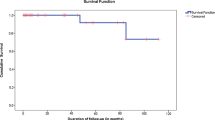Summary
Clinical data from Granulosa cell tumors (GCT) of the ovary were compared with data from 528 cases of malignant ovarian tumor in regard to symptomatology, treatment and prognosis. GCT are more frequent under the age of 30 and their biology requires a clinical separation from other feminizing mesenchymal tumors. Irregularities of ulterine bleeding as a result of hormonal activity were the most frequent symptoms, explaining why their diagnosis is earlier than in ovarian cancer. The 5-year survival rates were similar when tumor stages were compared. GCT is associated with a frequency of late recurences after 5, 10 or more years but a potential risk of malignancy is not related to clinical or histological criteria. Abdominal hysterectomy with bilateral salpingoophorectomy is standard treatment, whereas radiation and chemotherapy seem to be of little value.
Similar content being viewed by others
References
Anderson WR, Levine AJ, MacMillan D (1971) Granulosa-theca cell tumors: Clinical and pathologic study. Am J Obstet Gynecol 110:32–35
Anikwue C, Dawood MY, Kramer E (1978) Glanulosa and theca cell tumors. Obstet Gynecol 51:214–220
Beckmann M, Schweppe, K-W, Beller FK (1980) Gleichzeitiges Vorkommen von Granulosa-Zell-Tumoren und Endometriumkarzinom. Vortrag Niederrh.-Westf. Ges. Gyn. u. Geb., 169. Sitzung, Köln, 26.4. 1980
Bellwin A, Goldberg MA (1953) Granulosa cell tumors J Mt Sinai Hosp 20:229
Bruk J. Dancaster, DP, Jackson WPU (1960) Granulosa cell tumors causing precocious puberty: oestrogen fractionations in two patients. Br Med J 2:26–32
Busby T, Anderson GW (1954) Feminizing mesenchymomas of the ovary. Includes 107 cases of granulosa-, granulosa-theca-cell, and theca-cell tumors. Am J Obstet Gynecol 68:1391–1420
Diddle AW (1952) Granulosa- and theca-cell ovarian tumors: prognosis. Cancer 5:215–228
Dockerty MB, Mussey E (1951) Mallgnant lesions of the uterus associated with estrogen-producing ovarian tumors. Am J Obstet Gynecol 61:147–153
El-Minawi MF, Hori JM (1974) The curability of granulosa-theca cell tumors. Current concepts. Int J Gynaec Obstet 12:10–18
Engeler V (1974) Ovarialkarzinom Fortschritte der Geburtshilfe und Gynäkologie. Karger, Basel (Bd 53, S. 47–49)
Felmus LB, Pedowitz P (1967) Clinical malignancy of endocrine tumors of the obary and dysgerminoma. Obstet Gynecol 29:344–350
Fox H, Agrawal K, Langley FA (1975) A clinicopathologic study 92 cases of granulosa cell tumor of the ovary with special references to the factor influencing prognosis. Cancer 35:231–241
Gillibrand PN (1966) Granulosa-theca cell tumors of the ovary associated with pregnancy. Case report and review of the literature. Am J Obstet Gynecol 94:1108–1111
Goldston WR, Johnston WW, Fetter BF, Parker RT, Wilbanks GD (1972) Clinicopathologic studies in feminizing tumors of the ovary. I. Some aspects of the pathology and therapy of granulosa cell tumors. Am J Obstet Gynecol 112:422–429
Haines M, Jackson I (1957) Granulosa cell tumors of the ovary — An analysis of 40 cases. J Obstet Gynaecol Br Commonw 57:737–746
Hodgson JE, Dockerty MB, Mussey RD (1945) Granulosa cell tumor of the ovary. Surg Gynec Obstet 81:631–642
Janovski N (1980) Histologie und Einteilung der Ovarialtumoren. In: Schwalm H, Döderlein G, Wulf KH (Hrsg) Klinik der Frauenheilkunde und Geburtshilfe, Bd 8. Urban und Schwarzenberg, München Wien Baltimore, S 680–685
Kent SW, McKay DG (1960) Primary cancer of the ovary: An analysis of 349 cases., Am J Obstet Gynecol 80:430–438
Knörr K, Beller FK, Lauritzen CH (1972) Lehrbuch der Gynäkologie. Springer, Berlin Heidelberg New York, p 367
Kottmeier HL (1961) Ovarian cancer. Cancer Bull Houston 13:34–43
Kottmeier HL (1961) Radiotherapy in the treatment of ovarian carcinoma. Clin Obstet Gynecol 4:865–874
Kottmeier HL (1968) Clinical staging in ovarian carcinoma. In: Ovarian cancer UICC, Vol 11. Springer, Berlin Heidelberg New York, p 146
Kottmeier HL (1971) Ovarian cancer with special regard to radiotherapy. Am J Roentgenol 111:417–429
McCormack TP, Riddick DH (1976) Hormonal function of the granulosa cell tumor. Obstet Gynecol 48:18s-21s
Malkasian GD, Webb MJ, Jorgensen ED (1974) Observations on chemotherapy of granulosa cell carcinomas and malignant ovarian teratomas. Obstet Gynecol 44:885–888
Norris HJ, Taylor HB (1968) Prognosis of granulosa theca tumors of the ovary. Cancer 21:255–263
Novak ER, Kutchmeshgi J, Mupas RS, Woodruff JD (1971) Feminizing gonadal stromal tumors —Analysis of the granulosa-theca cell tumors of the ovarian tumor registry. Obstet Gynecol 38:701–713
Novak ER, Woodruff JD (1974) Gynecologic and obstetric pathology with clinical and endocrine relation: 7th ed. Saunders, Philadelphia pp 449–468
Ortner A, Scharf O, Weiser G (1980) Untersuchungen über die Beziehungen zwischen “hormonaktiven” Ovarialtumoren und Veränderungen des Endometriums. Wien Klin Wochenschr 92:499
Pankratz E, Boyes DA, White GW, Galliford BW, Fairey RN, Benedet JL (1978) Granulosa cell tumors. A clinical review of 61 cases. Obstet Gynecol 52:718–723
Rokitansky CV (1859) Über Abnormalitäten des Corpus luteum. Allg Wien Med Z 4:253
Schreiner WE (1971) Endokrin-aktive Ovarialtumoren. In: Labhart A (Hrsg) Klinik der inneren Sekretion. Springer, Berlin Heidelberg New York S 655
Schwartz PE, Smith JP (1976) Treatment of ovarian stromal tumors. Am J Obstet Gynecol 125:402–411
Sievers S, Dallenbach-Hellweg G, Sueemihl D, Pohl R (1981) Die Prognose der malignen Ovarialtumoren in Abhängigkeit vom histopathologischen Bund. Geburtshilfe Frauenheilkd 41:10–14
Sjostedt S, Wahlen T (1961) Prognosis of granulosa cell tumors. Acta Obstet Gynecol Scand [Suppl] 40:1–26
Smith JP, Rutledge F (1970) Chemotherapy in the treatment of cancer of the ovary. Am J Obstet Gynecol 107:691–703
Spinelli A, Morf P, Genton C (1979) Die Granulosa-Thekazelltumoren. Eine klinisch-pathologisch-anatomische Studie über 25 Fälle. Geburtshilfe Frauenheilkd 39:882–887
Stabnick JS (1940) Granulosa cell tumor in an 80-year-old patient-case report. Memphis MJ 15:82–84
Zemke EE, Herrell WE (1941) Bilateral granulosa cell tumor; successful removal from a child fourteen weeks of age. Am J Obstet Gynecol 41:704–707
Author information
Authors and Affiliations
Rights and permissions
About this article
Cite this article
Schweppe, K.W., Beller, F.K. Clinical data of Granulosa cell tumors. J Cancer Res Clin Oncol 104, 161–169 (1982). https://doi.org/10.1007/BF00402064
Received:
Accepted:
Issue Date:
DOI: https://doi.org/10.1007/BF00402064




